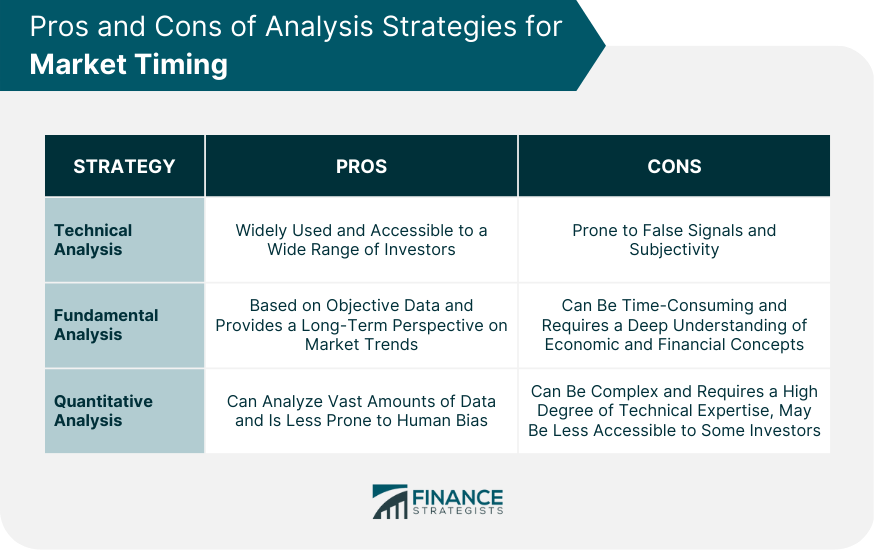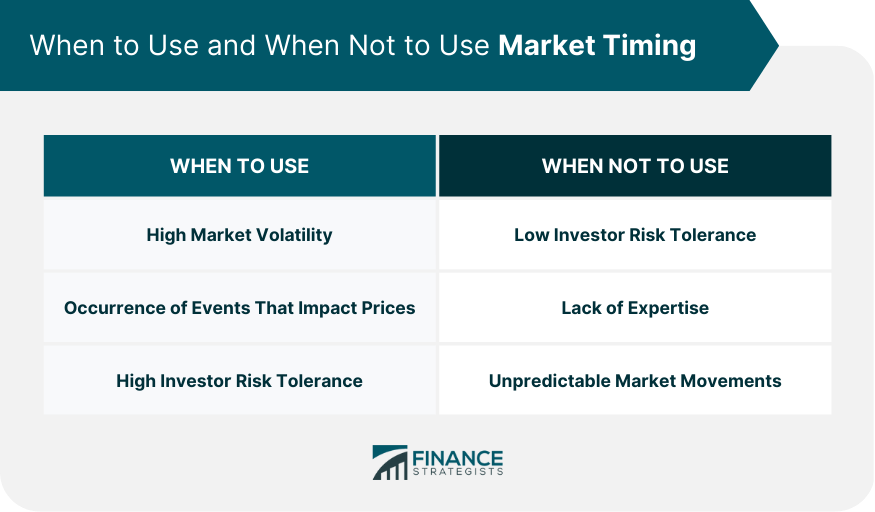Market timing refers to the practice of buying and selling assets, such as stocks and bonds, with the aim of profiting from fluctuations in their prices. The goal of market timing is to identify and capitalize on changes in market conditions that will lead to price increases or decreases. This requires a deep understanding of the underlying economic and financial factors that affect the markets, as well as the ability to accurately predict short-term price movements. Market timing is important in investing because it offers the potential to generate higher returns than simply buying and holding assets over the long term. By identifying and taking advantage of market movements, investors can profit from short-term price fluctuations, potentially boosting their overall returns. However, market timing also involves a significant degree of risk, as it requires accurate timing and can lead to losses if done incorrectly. This strategy uses the following ways to analyze the market: Technical analysis is one of the most widely used strategies for market timing. It involves studying charts and other technical indicators to identify patterns and trends in asset prices, with the goal of predicting future price movements. Technical analysts use a variety of tools to analyze market data, including moving averages, relative strength index (RSI), and moving average convergence divergence (MACD). One advantage of technical analysis is that it can be used to analyze any asset that is traded in a market, including stocks, bonds, and commodities. It is also a relatively simple and straightforward strategy to implement, making it accessible to a wide range of investors. However, technical analysis can be prone to false signals and is often criticized for being subjective and prone to human bias. Fundamental analysis is another strategy that can be used for market timing. It involves analyzing the underlying economic and financial factors that drive asset prices, such as company earnings, interest rates, and economic indicators. By understanding these factors and their impact on asset prices, investors can make informed decisions about when to buy or sell assets. One advantage of fundamental analysis is that it is based on objective data, making it less prone to subjective interpretation than technical analysis. It also provides a more long-term perspective on market trends, which can help investors make more strategic investment decisions. Fundamental analysis can be time-consuming and requires a deep understanding of economic and financial concepts. Quantitative analysis is a more advanced strategy for market timing that involves using mathematical models and statistical methods to predict market movements. This approach relies on large amounts of data and complex algorithms to identify patterns and trends in asset prices, with the goal of generating more accurate predictions of future price movements. One advantage of quantitative analysis is that it can be used to analyze vast amounts of data, providing a more comprehensive view of market trends than other strategies. It is also less prone to human bias, as it relies on objective data and mathematical models. However, quantitative analysis can be complex and requires a high degree of technical expertise, making it less accessible to some investors. The following are some of the risks and challenges that investors should be aware of when using market timing: One of the biggest risks of market timing is timing errors. Accurately timing the markets is difficult, and even small errors in timing can lead to significant losses. Investors who are considering market timing should have a deep understanding of market trends and the ability to accurately predict short-term price movements. Market timing also involves a higher degree of trading activity than a buy-and-hold strategy, which can lead to higher transaction costs. These costs can eat into potential returns and reduce the overall effectiveness of market timing as an investment strategy. Finally, market timing can be impacted by psychological biases, such as fear and greed. These biases can lead investors to make emotional, knee-jerk decisions based on short-term price movements, rather than taking a more strategic, long-term approach to investing. Here are some of the tools and resources that investors can use for market timing: Staying up-to-date with the latest financial news is an important tool for market timing. Financial news sources such as Bloomberg, CNBC, and The Wall Street Journal provide valuable insights into market trends and can help investors make decisions about when to buy or sell assets. Charting software is another important tool for market timing. This software allows investors to analyze historical price data and identify trends and patterns in asset prices. Some popular charting software options include TradingView, StockCharts.com, and MetaTrader. Finally, market data providers such as Bloomberg and Thomson Reuters provide real-time market data and analytics that can be used for market timing. These providers offer access to a wealth of market data, including historical price data, news feeds, and economic indicators. It is important to understand when it is appropriate to use market timing: One of the key times to use market timing is during times of high market volatility. When markets are experiencing large swings in prices, investors can use market timing to take advantage of short-term price movements and potentially generate higher returns. It is important to note that market timing during times of volatility can also be risky, as it requires accurate timing and can lead to losses if done incorrectly. Another time to consider market timing is when there are specific events that may impact asset prices. For example, changes in interest rates, political events, and economic data releases can all impact asset prices, and market timing can be used to take advantage of these events. However, it is important to approach market timing during these times with caution, as events can be difficult to predict and market movements can be unpredictable. Finally, market timing can be appropriate for investors who have a high-risk tolerance and are comfortable with a higher degree of risk. Market timing is a more active investment strategy than a buy-and-hold approach, and it requires a higher degree of expertise and attention to the markets. For investors who are willing to take on more risk, market timing can provide the potential for higher returns. While market timing can be a powerful investment strategy, it is not appropriate for all investors and all situations. There are times when it may be better to avoid market timing altogether. One situation where market timing may not be appropriate is when an investor has a low-risk tolerance. Market timing is a more active investment strategy than a buy-and-hold approach, and it can be risky if done incorrectly. Investors who are uncomfortable with a higher degree of risk, a buy-and-hold strategy may be a better option. Market timing may not be appropriate when an investor does not have the expertise or resources to accurately time the markets. Market timing requires a deep understanding of market trends and the ability to accurately predict short-term price movements. For investors who do not have the necessary expertise or access to market data, market timing may not be a viable option. Unpredictable market movements are a significant challenge for investors who are considering using market timing as an investment strategy. While market timing can be a powerful tool for generating higher returns, it requires accurate timing and predictions of market movements. When markets are unpredictable, it can be difficult for investors to accurately predict short-term price movements, leading to potential losses. Market timing is an investment strategy that involves buying and selling assets based on short-term market movements. It requires a deep understanding of market trends and the ability to accurately predict short-term price movements. There are several analysis strategies that can be used for market timing, including technical analysis, fundamental analysis, and quantitative analysis. To effectively use market timing as an investment strategy, it is important to have access to the right tools and resources. These tools can help investors make informed decisions about when to buy or sell assets. It is also important to approach market timing with caution and to use it in conjunction with other investment strategies, as market timing carries a higher degree of risk. Investors should also be aware of the risks and challenges of market timing, including timing errors, transaction costs, and psychological biases. To mitigate these risks, investors should approach market timing with caution and seek the guidance of a wealth management expert.Definition of Market Timing
Understanding Market Timing
Technical Analysis
Fundamental Analysis
Quantitative Analysis

Risks and Challenges of Market Timing
Timing Errors
Transaction Costs
Psychological Biases
Tools and Resources Available for Market Timing
Financial News
Charting Software
Market Data Providers
When to Use Market Timing
High Market Volatility
Occurrence of Events That Impact Prices
High Investor Risk Tolerance
When Not to Use Market Timing
Low Investor Risk Tolerance
Lack of Expertise
Unpredictable Market Movements

Final Thoughts
Market Timing FAQs
Market timing is an investment strategy that involves buying and selling assets based on short-term market movements.
The risks of market timing include timing errors, transaction costs, and psychological biases. Accurately timing the markets is difficult, and even small errors in timing can lead to significant losses.
To effectively use market timing, it is important to have access to the right tools and resources, including financial news, charting software, and market data providers. It is also important to approach market timing with caution and to use it in conjunction with other investment strategies.
Market timing is not suitable for investors who have a low-risk tolerance or who do not have the expertise or resources to accurately time the markets. Unpredictable market movements can also make market timing a risky strategy.
Wealth management services can provide guidance and expertise for investors who are considering market timing as an investment strategy. They can help investors mitigate the risks and challenges of market timing and develop a comprehensive investment plan that takes into account their risk tolerance, time horizon, and investment goals.
True Tamplin is a published author, public speaker, CEO of UpDigital, and founder of Finance Strategists.
True is a Certified Educator in Personal Finance (CEPF®), author of The Handy Financial Ratios Guide, a member of the Society for Advancing Business Editing and Writing, contributes to his financial education site, Finance Strategists, and has spoken to various financial communities such as the CFA Institute, as well as university students like his Alma mater, Biola University, where he received a bachelor of science in business and data analytics.
To learn more about True, visit his personal website or view his author profiles on Amazon, Nasdaq and Forbes.















